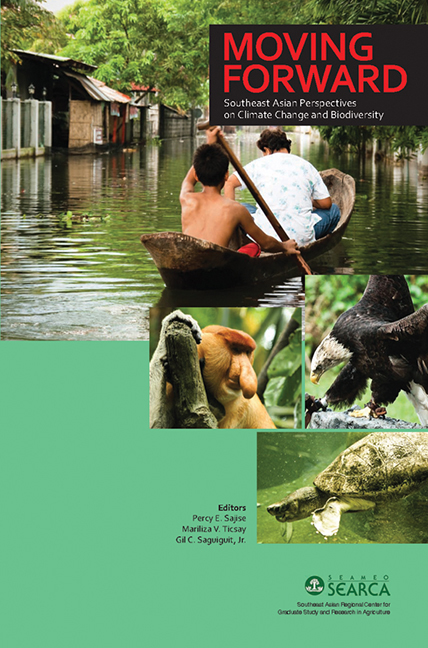Book contents
- Frontmatter
- Contents
- Tables
- Figures
- Foreword
- Preface
- Contributors
- Acronyms
- INTRODUCTION
- REGIONAL PERSPECTIVES AND CROSS-CUTTING ISSUES
- COUNTRY PERSPECTIVES
- 5 Animal Genetic Resource Conservation and Climate Change in Cambodia: Reducing Livestock to Decrease GHG Emission?
- 6 Malaysia's Current Policy and Research Initiatives Toward Climate Change: Impacts to Biodiversity
- 7 Anticipated Impacts of Climate Change on Marine Biodiversity: Using Field Situations that Simulate Climate Change in Singapore
- 8 Climate Change and Biodiversity in the Philippines: Potential Impacts and Adaptation Strategies
- 9 Research Initiatives on Climate Change Impacts and Adaptation in Thailand
- 10 The Role of Biodiversity in Climate Change Mitigation in Vietnam: The Red River Estuary - Ba Lat Case Study
- 11 Implications of the Dutch-Philippines Biodiversity Research on the Impacts, Vulnerability, and Adaptation to Climate Change: The Coastal Ecosystem
- CHALLENGES AND FUTURE ACTIONS
- Index
7 - Anticipated Impacts of Climate Change on Marine Biodiversity: Using Field Situations that Simulate Climate Change in Singapore
from COUNTRY PERSPECTIVES
Published online by Cambridge University Press: 21 October 2015
- Frontmatter
- Contents
- Tables
- Figures
- Foreword
- Preface
- Contributors
- Acronyms
- INTRODUCTION
- REGIONAL PERSPECTIVES AND CROSS-CUTTING ISSUES
- COUNTRY PERSPECTIVES
- 5 Animal Genetic Resource Conservation and Climate Change in Cambodia: Reducing Livestock to Decrease GHG Emission?
- 6 Malaysia's Current Policy and Research Initiatives Toward Climate Change: Impacts to Biodiversity
- 7 Anticipated Impacts of Climate Change on Marine Biodiversity: Using Field Situations that Simulate Climate Change in Singapore
- 8 Climate Change and Biodiversity in the Philippines: Potential Impacts and Adaptation Strategies
- 9 Research Initiatives on Climate Change Impacts and Adaptation in Thailand
- 10 The Role of Biodiversity in Climate Change Mitigation in Vietnam: The Red River Estuary - Ba Lat Case Study
- 11 Implications of the Dutch-Philippines Biodiversity Research on the Impacts, Vulnerability, and Adaptation to Climate Change: The Coastal Ecosystem
- CHALLENGES AND FUTURE ACTIONS
- Index
Summary
Increasing evidences demonstrate that climate change affects natural systems and causes significant impacts on biodiversity (IPCC 2007). On marine systems, the impacts of climate change include elevated sea temperature, and changes in salinity, oxygen, pH levels, and circulation, among others. Although it is not easy to isolate climate change impacts on natural systems from adaptation and non-climatic drivers, it is not altogether impossible to anticipate these impacts. Impacts can be seen from existing scenarios that simulate climate change conditions. These impacts may be simple as they do not take into account the uncertainties of the complex interaction of causal factors and the exacerbations of human activities.
Climate change results in the greater frequency of extreme weather events, elevated sea temperatures, rise in sea levels, and more intense stratification of the water column (Chou 1994). These impacts generate entire suites of accompanying environmental effects on coastal and marine systems. The effects include coastal erosion, sudden salinity fluctuation, increased sedimentation, nutrient loading, salt water intrusion, coastal inundation, and changes in coastal geomorphology and circulation patterns (Chou 1992).
Singapore's intensive coastal development, including coastal reclamation, provides many field conditions that adequately represent some aspects of climate change impacts. Attention is drawn to a few case studies, which, in spite of limitations, give an adequate idea of expected impacts on marine biodiversity. These case studies dealt with sedimentation, natural colonisation of human-made habitats, salinity depression, and sea surface temperature elevation.
NATURAL COLONISATION OF ARTIFICIAL HABITAT
The reef flats of a few southern offshore islands have been reclaimed for a variety of reasons. One such island is Pulau Hantu, which was reclaimed to enhance its recreational potential.
Located 8 km south of the main island of Singapore, Pulau Hantu originally consisted of two small adjacent islands, Pulau Hantu Besar (2 ha) and Pulau Hantu Kechil (0.4 ha). These two islands were surrounded by fringing reefs. They also shared a common reef flat between them.
- Type
- Chapter
- Information
- Moving ForwardSoutheast Asian Perspectives on Climate Change and Biodiversity, pp. 131 - 140Publisher: ISEAS–Yusof Ishak InstitutePrint publication year: 2010



